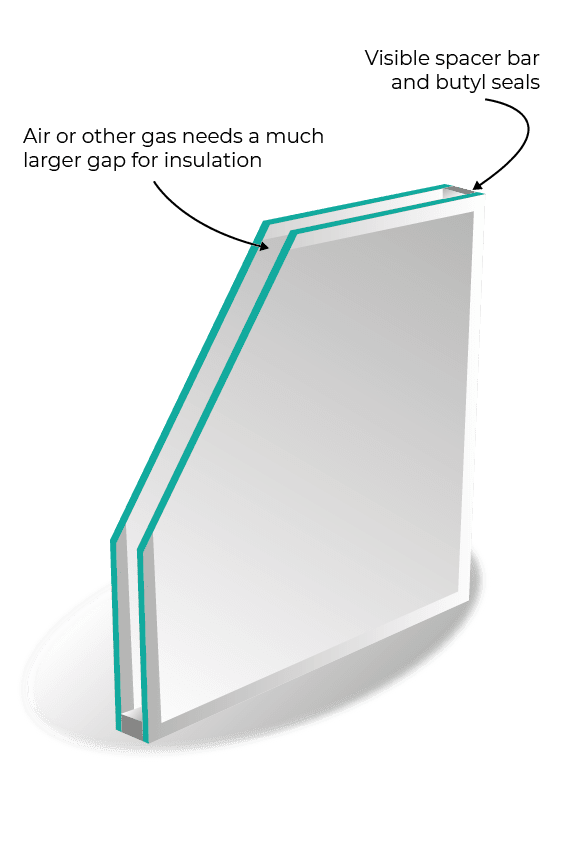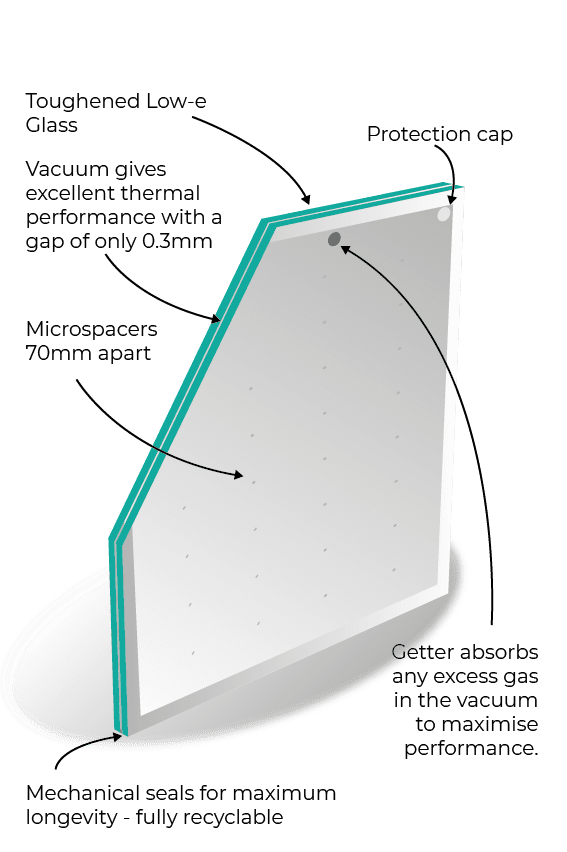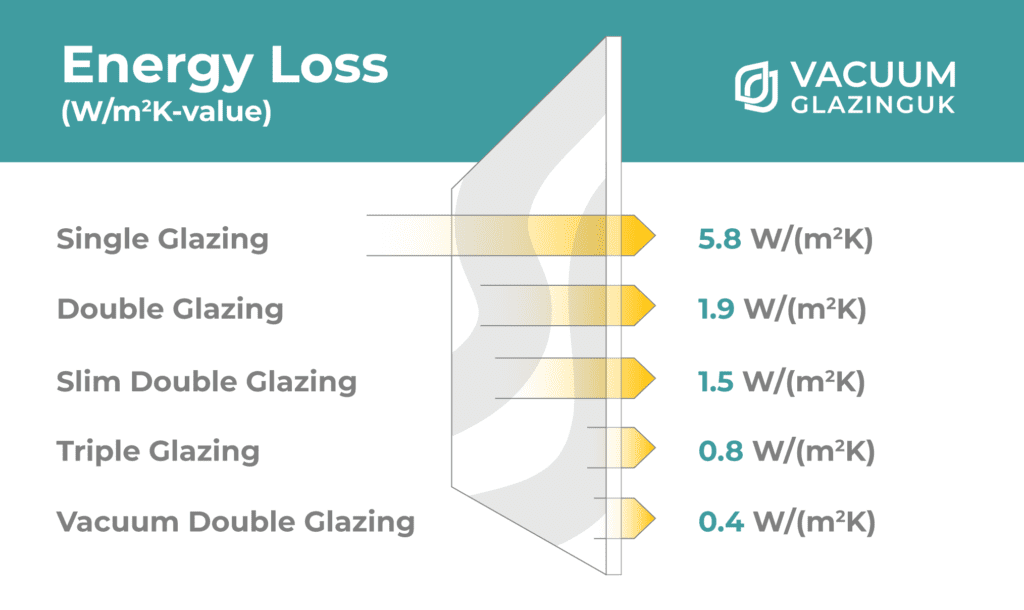A guide to Vacuum Double Glazing
Vacuum double glazing, also known as vacuum-insulated glazing (VIG), is an advanced type of glass technology that enhances thermal insulation and soundproofing. Unlike conventional double glazing, VIG features two panes of glass separated by a vacuum cavity, which significantly reduces heat transfer. This cutting-edge solution is particularly relevant for European homeowners seeking to improve their property’s energy efficiency while maintaining architectural integrity.
Why Choose Vacuum Double Glazing?
European regulations on energy efficiency and sustainability continue to evolve, making high-performance glazing an essential investment. VIG offers unparalleled insulation, reducing energy consumption and lowering carbon footprints in compliance with EU climate targets.
Exceptional Energy Efficiency
Centre-pane U-values as low as 0.4, surpassing passive house requirements.
Ultra-Slim Profile
Just 8.3mm thick, seamlessly integrating into heritage and modern buildings.
Durability and Longevity
Toughened glass with a resilient edge seal and a 15-year warranty.
How Standard Double Glazing Works
Standard double glazing consists of two glass panes separated by an inert gas, such as argon, which reduces heat transfer. While this method improves insulation compared to single glazing, it has limitations, particularly in historic buildings and conservation areas.
Standard Double Glazing

Vacuum Glazing

Why Traditional Double-Glazed Windows Often Fall Short
Double-glazed windows have long been seen as a step up from outdated single glazing, offering better insulation and noise reduction. However, they come with their own set of drawbacks—especially in Eastern Europe, where architectural heritage and colder climates create unique challenges.
One of the most noticeable issues is the thickness of standard double-glazed units. With an air gap of 14mm to 25mm between the panes, these windows require bulky internal frames to hold them in place. Unfortunately, these thick frames can look awkward, particularly in buildings with classic or historical features. They tend to disrupt the original aesthetics of the property, which can be a major concern in conservation areas or when renovating heritage homes.
In many Eastern European countries, older buildings still retain their beautiful original wooden windows—often single-glazed and finely crafted. Modern building regulations and energy efficiency goals mean that these windows are no longer practical, but simply replacing them with thick, modern-looking double glazing isn’t an acceptable solution. Local planning authorities and heritage consultants often insist that any upgrades must preserve the authentic appearance of the original windows. Standard double glazing rarely meets this requirement, making it a poor fit for restorations.
Another visual problem is the “double reflection” caused by the distance between the two panes. This optical distortion is particularly noticeable in daylight and often disqualifies standard units from being used in sensitive renovation projects.
To bridge the gap, manufacturers introduced ultra-slim double-glazed units, designed to resemble single glazing while offering improved thermal performance. However, these thinner units often face reliability issues. Because the seals and edge spacers are reduced in size, they are more prone to early failure. In some cases, product quality concerns have even led to legal disputes, with industry bodies like the Glass and Glazing Federation taking action against certain manufacturers.
In summary, while traditional double glazing might work well for modern buildings, it often fails to deliver the right balance of performance and aesthetics for Eastern Europe’s many historic homes. A more advanced, reliable alternative is needed—especially one that respects both the architectural character and the thermal demands of the region.
The Science Behind Vacuum Insulated Glazing
Vacuum insulated glazing (VIG) is a breakthrough in window technology, offering exceptional thermal and acoustic performance in a much thinner profile than traditional double glazing. This makes it especially valuable in Eastern Europe, where preserving historic window frames while improving energy efficiency is a common challenge.
The key to VIG’s effectiveness lies in the space between the glass panes. In standard double-glazed units, this cavity is filled with air or inert gas. But in vacuum glazing, the air is completely removed, creating a vacuum—a space with no particles to conduct heat or sound. Since neither heat nor sound waves can travel through a vacuum, the result is outstanding insulation in a very slim unit.
Unlike conventional glazing systems that require a thick gap to work effectively, vacuum glazing achieves the same or better performance with a gap of less than 1mm. That means it can be installed in delicate or narrow window frames without compromising the look of the building. Whether it’s a 19th-century townhouse in Bucharest or a rural cottage in Slovakia, vacuum glazing helps maintain original aesthetics while meeting modern comfort standards.
This cutting-edge solution offers the best of both worlds: historic charm and 21st-century energy performance.

What are the Benefits of Vacuum Double Glazing?
Reduce Heat Loss
- Warmer Rooms
- Lower Energy Bills
- Better for the Environment
Reliability
- Extended service life
- 15 year guarantee
- No history of failure
Better Looking
- Allow more light into rooms
- No ugly sight lines
- Ultra slim profile
Reduce Noise
- Quieter indoors
- Less outside noise
- More privacy & focus
Seamless Integration
- Seamless integration into existing frames
- Minimal disruption to building fabric
- Cost-effective installation in new or retrofit projects
Wide Availability
- Widely available in the UK
- Quick and reliable lead times
- Versatile and customizable shapes and sizes
Why Choose Vacuum Glazing? A Smarter Solution for Eastern European Homes
Vacuum insulated glazing offers a powerful upgrade over traditional double-glazed windows—especially in regions where energy costs are rising and preserving architectural character is essential.
Thanks to the vacuum-sealed gap between the glass panes, these units dramatically reduce heat loss. With no air or gas between the panes, there’s simply no way for heat to escape. The result? A much lower U-value than even modern triple glazing—keeping your home warmer in winter and cooler in summer, while reducing energy bills all year round.
Noise reduction is another major advantage. In busy urban areas—from historic city centres in Kraków or Vilnius to growing suburbs around Belgrade—external noise can be a constant frustration. Because sound waves can’t pass through a vacuum, these windows significantly block out traffic, voices, and other everyday disturbances.
Beyond performance, vacuum glazing also supports heritage restoration goals. Its ultra-slim profile allows it to be installed in original timber frames without spoiling the building’s historic appearance—making it a preferred choice for planning authorities and conservation projects.
Key Benefits:
- Superior thermal insulation – helps retain indoor warmth, even in harsh winters
- Exceptional noise reduction – enjoy a more peaceful home, even in noisy surroundings
- Discreet, elegant design – ideal for restoring period buildings without compromising on efficiency
- Better compliance with heritage regulations – slim enough for use in protected buildings
Vacuum glazing brings comfort, performance, and aesthetics together—ideal for both historic and modern Eastern European homes.

Cost vs. Value: Is Vacuum Double Glazing Worth It?
Although vacuum double glazing carries a higher initial cost than traditional double glazing, its long-term benefits far outweigh the investment. The resilient perimeter seal, extended lifespan, and superior insulation make it a cost-effective solution when considering total life-cycle savings. Homeowners across Europe are increasingly adopting VIG as a sustainable, high-performance alternative.
Conclusion
Vacuum double glazing is redefining energy efficiency in European homes. Whether you’re looking to preserve a historic building, reduce your energy costs, or improve comfort levels, VIG is a future-proof solution that meets the highest performance standards. With enhanced thermal insulation, noise reduction, and an ultra-slim design, this innovative glazing technology ensures compliance with European building regulations while delivering unmatched benefits for homeowners and architects alike.